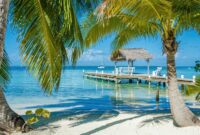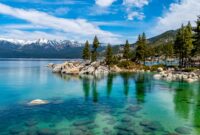Best retirement trips represent a significant milestone, offering the chance to explore the world and pursue passions with newfound freedom. This guide delves into the planning and execution of unforgettable retirement adventures, addressing budgetary concerns, ideal destinations, diverse trip types, and logistical considerations. Whether you envision a relaxing beach escape, an adventurous trek, or a culturally enriching immersion, we provide the tools to make your dream retirement trip a reality.
From meticulously crafted itineraries to insightful tips on saving money and navigating accessibility challenges, this comprehensive resource equips you to plan a retirement trip that perfectly aligns with your preferences and budget. We explore various travel styles, highlighting both popular and lesser-known destinations, to ensure a journey that’s both enriching and tailored to your individual needs.
Budget Considerations for Retirement Trips
Planning a retirement trip requires careful consideration of your budget. The cost can vary dramatically depending on your travel style and chosen destination. Understanding different budget levels and strategies for saving money is crucial for a memorable and stress-free experience.
Budget Levels for Retirement Trips
The cost of a retirement trip can be categorized into three main budget levels: Luxury, Mid-range, and Budget-friendly. Each level offers a different travel experience and involves different spending priorities. The following table provides examples for each level.
| Budget Level | Destination Examples | Activities | Estimated Cost (per person, 10 days) |
|---|---|---|---|
| Luxury | Maldives, Switzerland, Bora Bora | Private villa stays, gourmet dining, spa treatments, private tours, first-class flights | $10,000 – $30,000+ |
| Mid-range | Italy, Portugal, Costa Rica | Comfortable hotels, local restaurants, guided tours, day trips, economy or business class flights | $3,000 – $8,000 |
| Budget-friendly | Southeast Asia (Thailand, Vietnam), Mexico, Eastern Europe | Hostels or budget hotels, local markets, public transportation, free walking tours, budget airlines | $1,000 – $3,000 |
Note: These cost estimates are approximate and can vary based on factors such as the time of year, specific activities chosen, and personal spending habits.
Saving Money on Travel Expenses
Several strategies can help retirees save money on their travel expenses. Careful planning and resourcefulness are key.
Saving money on flights can be achieved by booking in advance, being flexible with travel dates, considering budget airlines, and using flight comparison websites. Accommodation costs can be reduced by opting for Airbnb, guesthouses, or hostels instead of luxury hotels. Prioritizing free or low-cost activities such as hiking, exploring local markets, and visiting free museums can significantly reduce overall expenses. Preparing some meals yourself instead of eating out for every meal can also save a considerable amount of money. Finally, utilizing travel rewards programs and credit card points can help offset the cost of flights and accommodation.
Factors Influencing Trip Costs
Several factors significantly influence the overall cost of a retirement trip. Understanding these factors allows for better budgeting and planning.
The time of year significantly impacts prices. Traveling during peak season (holidays, summer months) generally results in higher costs for flights and accommodation. Conversely, off-season travel offers lower prices but might mean less favorable weather conditions. The mode of transportation chosen greatly influences costs. Flying is generally more expensive than traveling by bus or train, especially for long distances. Accommodation type plays a crucial role. Luxury hotels and resorts are significantly more expensive than budget-friendly options like hostels or guesthouses. Finally, the chosen destination’s overall cost of living directly impacts spending. Destinations with a higher cost of living (e.g., Western Europe) will naturally be more expensive than those with a lower cost of living (e.g., Southeast Asia).
Popular Retirement Trip Destinations
Choosing the perfect retirement trip destination requires careful consideration of personal preferences and priorities. Whether you crave adventure, relaxation, or cultural immersion, numerous locations worldwide cater to diverse tastes and budgets. This section explores five popular destinations, highlighting their unique attractions and suitability for various retirement travel styles. We’ll also briefly touch upon some lesser-known alternatives.
Five Popular Retirement Trip Destinations
This section details five popular destinations, examining their pros and cons for retirees. We consider factors crucial to a comfortable and enjoyable trip, including accessibility, climate, and cost of living.
1. Portugal: Portugal offers a blend of history, culture, and stunning coastal scenery. Its mild climate, affordable cost of living (particularly outside major cities), and relatively accessible healthcare system make it attractive to retirees. The charming towns and villages, delicious cuisine, and rich history provide ample opportunities for exploration and relaxation. However, while the cost of living is generally lower than many Western European countries, it’s rising, and some areas might lack the same level of English proficiency as others.
2. Costa Rica: Known for its biodiversity and eco-tourism, Costa Rica appeals to adventurous retirees. The country boasts lush rainforests, pristine beaches, and abundant wildlife. While the cost of living can be moderate to high depending on lifestyle and location, the climate is generally warm and pleasant year-round. However, accessibility in some remote areas might be limited, and healthcare infrastructure, while improving, may not be as advanced as in some other countries.
3. Italy: Italy is a classic choice for culture-seeking retirees. Rich in history, art, and architecture, it offers a vibrant lifestyle with delicious food and wine. Many smaller towns and villages offer a slower pace of life, making them ideal for relaxation. However, the cost of living, especially in popular tourist areas, can be high, and navigating the country’s bureaucracy can sometimes be challenging. Accessibility varies depending on the specific region and town.
4. Mexico: Mexico offers a diverse range of experiences, from ancient Mayan ruins to stunning beaches. The country boasts a warm climate, a rich culture, and a relatively lower cost of living compared to many Western countries. However, healthcare quality can vary significantly depending on location and access to private healthcare may be necessary for optimal care. Language barriers can also be a consideration.
5. Thailand: Thailand is a popular destination for retirees seeking a tropical paradise with a low cost of living. Its beautiful beaches, vibrant culture, and friendly people are major draws. However, healthcare quality varies, and while generally affordable, access to high-quality healthcare might require additional expense. The intense heat and humidity might not suit everyone.
Lesser-Known Retirement Trip Destinations
Beyond the well-trodden paths, several lesser-known destinations offer unique appeal for retirees seeking something different.
- Panama: Offers a blend of nature, culture, and a relatively affordable cost of living, with a tropical climate.
- Ecuador: Boasts diverse landscapes, from the Andes Mountains to the Galapagos Islands, combined with a relatively low cost of living.
- Medellín, Colombia: Known for its pleasant climate, vibrant culture, and relatively affordable cost of living.
- Malta: A beautiful island nation in the Mediterranean Sea, offering a rich history, stunning scenery, and a relaxed lifestyle.
- Portugal’s Algarve region (beyond the major tourist areas): Discover quieter, more authentic Portuguese life at a more affordable price.
Types of Retirement Trips
Planning your retirement trip involves considering your preferred activity level and travel style. The right trip will depend on your budget, physical capabilities, and personal preferences. A well-chosen trip can create lasting memories and contribute significantly to a fulfilling retirement.
Cruises
Cruises offer a convenient and all-encompassing travel experience. They often include meals, entertainment, and transportation between destinations. This eliminates the need for extensive planning and allows for relaxation and enjoyment of various onboard amenities.
Advantages of cruises include ease of travel, diverse onboard activities (from swimming pools and spas to shows and lectures), and the opportunity to visit multiple destinations without the hassle of repacking and changing hotels. Disadvantages can include potential crowds, limited shore time at each port, and the possibility of seasickness for some individuals. A cruise might be ideal for those seeking a relaxed pace with built-in entertainment and varied sightseeing opportunities.
All-Inclusive Resorts
All-inclusive resorts provide a similar level of convenience to cruises, offering a package deal that includes accommodation, meals, and often activities and drinks. These resorts are typically located in warm, sunny destinations, focusing on relaxation and leisure.
Advantages include the predictable cost and ease of planning. Everything is included, minimizing unexpected expenses. Disadvantages may include a lack of local cultural immersion and potential feelings of confinement if the resort is large and isolated. All-inclusive resorts are best suited for those prioritizing relaxation and convenience above cultural exploration or independent adventure.
Independent Travel
Independent travel offers the greatest flexibility and control over your itinerary. This option involves booking flights, accommodation, and activities separately, allowing for personalized exploration and tailoring the trip to your specific interests.
Advantages include greater freedom to explore at your own pace and discover hidden gems. Disadvantages include the increased planning and booking time required, as well as the potential for higher costs if not carefully managed. Independent travel is perfect for experienced travelers who value spontaneity and personalized experiences, but requires more planning and research.
Volunteer Tourism
Volunteer tourism combines travel with giving back to a community. This involves participating in projects that benefit local populations, such as environmental conservation, teaching, or healthcare support.
Advantages include a sense of purpose and fulfillment, alongside the opportunity to experience a different culture firsthand. Disadvantages can include the physical demands of some volunteer work and the need to carefully research organizations to ensure ethical and impactful projects. Volunteer tourism is suitable for those seeking a meaningful travel experience that combines personal growth with contributing to a worthy cause. It’s important to research organizations thoroughly to ensure their legitimacy and positive impact.
Planning and Logistics for Retirement Trips
Planning a retirement trip requires careful consideration of various factors to ensure a smooth and enjoyable experience. From creating a detailed itinerary to addressing health and safety concerns, meticulous preparation is key to maximizing the enjoyment of this well-deserved break. This section outlines crucial aspects of planning and logistics, offering practical advice to help you navigate the process.
Sample Itinerary: A Week in Tuscany, Italy
This sample itinerary illustrates a possible week-long trip to Tuscany, Italy, focusing on a balance of cultural exploration and relaxation. Costs are estimates and can vary based on season, choices, and personal preferences.
| Day | Activity | Estimated Cost |
|---|---|---|
| Day 1 | Arrival in Florence, check into hotel, evening stroll across Ponte Vecchio. | $150 (hotel, dinner) |
| Day 2 | Florence: Uffizi Gallery, Accademia Gallery (David), lunch, Duomo climb. | $100 (entry fees, lunch) |
| Day 3 | Day trip to Siena: Piazza del Campo, Duomo, explore the medieval streets. | $120 (transport, lunch) |
| Day 4 | Cooking class in a Tuscan farmhouse, followed by a delicious meal. | $180 (class, meal, transport) |
| Day 5 | Wine tasting in Chianti region, visit vineyards and enjoy the scenery. | $150 (wine tasting, transport, lunch) |
| Day 6 | Relaxing day: explore a local market, enjoy a leisurely lunch, and relax by the hotel pool. | $80 (lunch, market purchases) |
| Day 7 | Departure from Florence. | $50 (transport to airport) |
Total Estimated Cost: $830 (excluding flights and accommodation for the entire trip). This is a flexible example; costs can be adjusted based on your preferences for luxury versus budget travel.
Travel Insurance and Vaccinations
Securing comprehensive travel insurance is paramount. It protects against unforeseen circumstances such as medical emergencies, trip cancellations, lost luggage, and other potential problems. The level of coverage should be tailored to the specific destination and planned activities. For example, adventure travel necessitates more extensive coverage than a relaxing beach vacation. Furthermore, researching necessary vaccinations and recommended health precautions based on your destination is crucial. The Centers for Disease Control and Prevention (CDC) website offers detailed information on required and recommended immunizations for various countries. For instance, Yellow Fever vaccination might be required for travel to certain parts of Africa or South America, while other destinations may necessitate Hepatitis A and Typhoid vaccinations.
Packing Efficiently and Comfortably
Packing efficiently for a retirement trip involves strategic planning to minimize luggage weight while ensuring you have everything you need. Consider the climate and planned activities when selecting clothing items. Opt for versatile clothing items that can be mixed and matched, reducing the number of outfits needed. Rolling clothes instead of folding them can save space and minimize wrinkles. Utilize packing cubes to organize and compress your belongings. Remember essential toiletries, medications (with prescriptions), and any necessary adaptive equipment. Comfortable walking shoes are crucial, particularly for sightseeing. A lightweight, foldable backpack is useful for carrying daily essentials during excursions. Finally, a well-organized packing list will help avoid forgetting essential items.
Accessibility and Inclusivity in Retirement Travel
Retirement should be a time for exploration and adventure, and ensuring that travel is accessible to everyone, regardless of physical limitations or disabilities, is crucial. This section explores the considerations for inclusive travel planning, highlighting accessible options and resources available to retirees with special needs. A well-planned trip can accommodate a wide range of needs, allowing everyone to enjoy the rewards of retirement travel.
Accessible travel options are expanding rapidly, offering a broader range of choices for those with disabilities or mobility challenges. However, careful planning is essential to ensure a smooth and enjoyable experience. This involves considering not only the destination but also the specific needs of the traveler and the resources available to support them.
Accessible Travel Options and Accommodations
Many hotels and resorts now offer accessible rooms featuring features such as roll-in showers, grab bars, wider doorways, and lowered countertops. Cruise lines also provide accessible cabins and facilities. Airlines generally offer assistance with boarding and deplaning, and many airports have accessible restrooms and transportation options. For example, the Hilton Hotels & Resorts chain boasts a significant number of properties with certified accessible rooms, adhering to ADA standards. Similarly, many cruise lines, such as Royal Caribbean International, advertise accessible staterooms and onboard amenities. When booking, it is crucial to specify accessibility requirements to ensure the appropriate accommodations are reserved.
Transportation Considerations for Accessible Travel
Transportation is a critical aspect of accessible travel. Many airlines offer wheelchair assistance and pre-boarding privileges. Ground transportation options, such as accessible taxis and ride-sharing services, are increasingly available in major cities. However, it is advisable to pre-book accessible transportation to avoid delays or difficulties. For example, researching and booking accessible airport transfers in advance is essential, and confirming the availability of wheelchair-accessible vehicles with rental car companies is also vital. Planning transportation in advance is key to a smooth journey.
Resources for Planning Accessible Retirement Trips
Several organizations offer resources and assistance to retirees with special needs planning their travels. The Americans with Disabilities Act (ADA) provides guidelines for accessibility in public accommodations, including transportation and lodging. Organizations such as the National Disability Rights Network (NDRN) provide information and advocacy for individuals with disabilities. Travel agencies specializing in accessible travel can assist with planning itineraries and booking accessible accommodations and transportation. These agencies often have extensive knowledge of accessible destinations and can provide personalized support to ensure a seamless travel experience. Websites and online forums dedicated to accessible travel offer reviews and recommendations from other travelers with disabilities.
Illustrative Examples of Retirement Trips
Retirement offers a unique opportunity to explore the world and engage in experiences tailored to personal interests. The following examples illustrate the diverse possibilities available, showcasing the spectrum of relaxation, adventure, and cultural immersion. Each trip highlights the planning and considerations involved in creating a memorable and fulfilling retirement adventure.
A Relaxing Beach Vacation in the Maldives
Imagine waking to the gentle lapping of turquoise waves against pristine white sand. The air is warm and infused with the salty tang of the ocean, carrying the sweet fragrance of tropical flowers. A luxurious overwater bungalow provides breathtaking views of the Indian Ocean, its crystal-clear waters teeming with vibrant coral reefs and colorful fish. Days are spent lounging on the beach, the warm sun gently kissing your skin. The sound of the waves is a constant, soothing rhythm, punctuated by the occasional cry of seabirds. Evenings bring spectacular sunsets, painting the sky in fiery hues of orange, pink, and purple, followed by the quiet hum of the night, punctuated by the gentle rustling of palm leaves. This idyllic setting allows for complete relaxation, offering opportunities for swimming, snorkeling, or simply unwinding with a good book. The Maldivian experience is one of unparalleled tranquility, a perfect escape from the stresses of daily life.
An Adventurous Hiking Trip in the Himalayas
The Himalayas present a challenging yet rewarding adventure for seasoned hikers. Preparing for such a trip requires meticulous planning, including thorough research on the chosen trails, securing necessary permits, and assembling appropriate gear. This includes sturdy hiking boots, layers of warm clothing, a reliable backpack, and a first-aid kit. Physical fitness is paramount; months of training are essential to build stamina and endurance. The trek itself is a test of both physical and mental strength. Steep inclines, unpredictable weather, and high altitudes pose significant challenges. However, the rewards are immense. The breathtaking panoramic views of snow-capped peaks, the pristine beauty of alpine meadows, and the sense of accomplishment upon reaching a summit are unparalleled. The journey fosters a deep connection with nature and provides a profound sense of personal achievement. The experience is transformative, fostering resilience and self-reliance.
A Cultural Immersion Experience in Kyoto, Japan
Kyoto, Japan, offers a rich tapestry of cultural experiences. The sights, sounds, and smells create an immersive journey through history and tradition. Ancient temples, such as Kiyomizu-dera, with their intricate wooden architecture and serene gardens, provide a glimpse into Japan’s spiritual heritage. The vibrant colors of geishas’ kimonos and the delicate sounds of traditional music add to the sensory richness of the experience. Exploring bustling markets like Nishiki Market, with their abundance of fresh produce and local delicacies, provides an opportunity to interact with locals and sample authentic Japanese cuisine. Participating in a traditional tea ceremony offers a deeper understanding of Japanese etiquette and mindfulness. The experience is one of profound cultural immersion, leaving an indelible mark on the traveler’s understanding of Japanese culture and history. Learning a few basic Japanese phrases enhances interaction with locals, enriching the overall experience.
Last Point
Ultimately, the best retirement trips are those that fulfill personal aspirations and create lasting memories. By carefully considering budget, destination, trip type, and logistics, retirees can embark on adventures that rejuvenate the spirit and enrich their lives. This guide serves as a compass, navigating you through the planning process and empowering you to create a truly unforgettable experience. Remember, the journey is as important as the destination, so savor every moment and embrace the freedom of retirement travel.




